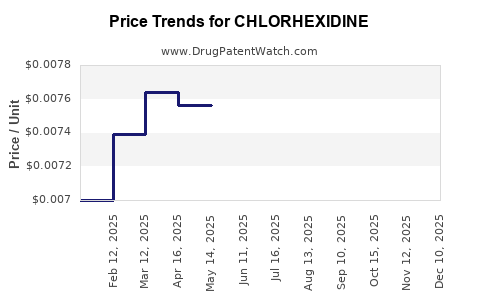Drug Price Trends for CHLORHEXIDINE
✉ Email this page to a colleague

Average Pharmacy Cost for CHLORHEXIDINE
| Drug Name | NDC | Price/Unit ($) | Unit | Date |
|---|---|---|---|---|
| CHLORHEXIDINE 0.12% RINSE | 00116-2001-04 | 0.01592 | ML | 2024-11-20 |
| CHLORHEXIDINE 0.12% RINSE | 00121-0893-16 | 0.00626 | ML | 2024-11-20 |
| CHLORHEXIDINE 0.12% RINSE | 00116-2001-16 | 0.00626 | ML | 2024-11-20 |
| CHLORHEXIDINE 0.12% RINSE | 62135-0649-47 | 0.00626 | ML | 2024-11-20 |
| CHLORHEXIDINE 0.12% RINSE | 16571-0128-48 | 0.00626 | ML | 2024-11-20 |
| CHLORHEXIDINE 4% LIQUID | 16571-0111-24 | 0.02907 | ML | 2024-11-20 |
| CHLORHEXIDINE 4% LIQUID | 16571-0111-48 | 0.02497 | ML | 2024-10-23 |
| >Drug Name | >NDC | >Price/Unit ($) | >Unit | >Date |
Best Wholesale Price for CHLORHEXIDINE
| Drug Name | Vendor | NDC | Count | Price ($) | Price/Unit ($) | Unit | Dates | Price Type |
|---|---|---|---|---|---|---|---|---|
| PERIOGARD ORAL RINSE | Colgate Oral Pharmaceuticals, Inc. | 00126-0272-16 | 473ML | 2.33 | 0.00493 | ML | 2023-09-01 - 2028-08-31 | FSS |
| CHLORHEXIDINE GLUCONATE 0.12% RINSE,ORAL | Golden State Medical Supply, Inc. | 00121-0893-16 | 473ML | 1.89 | 0.00400 | ML | 2023-06-15 - 2028-06-14 | FSS |
| CHLORHEXIDINE GLUCONATE 0.12% RINSE,ORAL | Golden State Medical Supply, Inc. | 00121-0893-16 | 473ML | 2.06 | 0.00436 | ML | 2023-06-23 - 2028-06-14 | FSS |
| HIBICLENS 4% LIQUID, TOP | TrillaMed, LLC | 00234-0575-32 | 12 X 960ML | 88.58 | 2022-05-15 - 2027-05-14 | FSS | ||
| HIBICLENS 4% LIQUID, TOP | TrillaMed, LLC | 00234-0575-41 | 24 X 120ML | 77.89 | 2022-05-15 - 2027-05-14 | FSS | ||
| HIBICLENS 4% LIQUID, TOP | TrillaMed, LLC | 00234-0575-91 | 4X3840ML | 99.06 | 2022-05-15 - 2027-05-14 | FSS | ||
| HIBICLENS 4% LIQUID, TOP | TrillaMed, LLC | 00234-0575-04 | 48 X 120ML | 109.59 | 2022-05-15 - 2027-05-14 | FSS | ||
| >Drug Name | >Vendor | >NDC | >Count | >Price ($) | >Price/Unit ($) | >Unit | >Dates | >Price Type |


